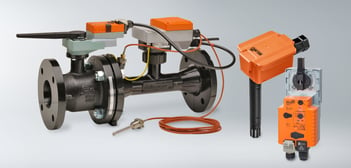Exploring the Internet of Things
One of the most prominent buzz terms in the HVAC market is the Internet of Things referred to as IoT. IoT is a digital network of physical devices, vehicles, buildings and many other items. These connected smart devices use electronics, software, and network connectivity to collect and exchange data. In simple terms, the Internet of Things are products or devices that talk to each other.
If you have a smartphone that communicates with a thermostat, able to checked on a buildings system operation parameters remotely, or used the location services function on your smartphone, you have used IoT. These applications are just a small sampling of IoT and the value that it brings to people’s lives.
Information technology research and advisory company, Gartner estimates that 6.4 billion devices were connected to the internet in 2016; that is a 30 percent increase over 2015. By 2020, it is expected that 21 billion devices will be connected. These devices are a mix of consumer products, across business and specific to vertical markets devices. The trend is rapidly moving to commercial buildings, which is attracting a significant amount of interest from technology leaders like Cisco, Google, IBM, and Microsoft.
An Ongoing Evolution
The first phase of the internet had people sharing information and talking over networks and computers. In a relatively short period, the transition from web pages, virtual bulletin boards, and email came social media and instant connectivity. Which led to devices talking to each other, which improve job efficiency. For example, by remotely checking in on a building’s automation system, a Facility Manager can identify trouble spots. Having the ability to know what parts are needed ensuring they are in the service truck before heading to the building.
The next phase is the ability to analyze the gathered information from other devices and making decisions based on the data. This is called “machine learning” and is a rapidly developing sector of artificial intelligence. An example, ever wonder how your phone predicts what you want to type? Learning the words you type and predicting what your next word will be is all part of machine learning.
Watch now to discover how smart connected actuators are making systems transparent. IoT actuators are improving installation and providing greater comfort over BACnet/IP and Modbus/TCP. With intelligent cloud connectivity, you can now optimize, commission, service, monitor, and maintain your building from anywhere.
The Cloud
Another buzzword from the past few years is “the cloud” and its relation to the Internet of Things. The cloud refers to cloud computing, where data is stored remotely and accessible by anyone or anything that has the appropriate security credentials. If you subscribe to Netflix, you are using the cloud. Netflix stores files in data centers that you access when you want to watch a movie.
With IoT, our devices (phones, thermostats, sensors, etc.) produce large amounts of data that is accessible. If we want our HVAC equipment, and other devices connected to the Internet of Things to process that data to make decisions for a building or business, the resources of the cloud come into play. As we add more smart sensors and internet-enabled metering devices to a building or home, we can monitor and perform predictive system maintenance easier and faster.
Think about it; if you could make preliminary system diagnosis of a problem remotely, how much travel and diagnostic time would this save? How much more business could you do by having this information readily available?
Smarter Homes
With 50% of IoT devices being consumer based, there is a large potential for working advanced functionality into home systems. Currently, devices allow homeowners to set and change temperature controls, lighting remotely, and even lock your front door and talk to someone at the door.
In the next few years, your home could be calling you to let you know it closed the windows and turned down the humidity because it checked the weather network and rain is predicted in the next hour. Or on your commute home, you your thermostat will automatically ramp up the heating or cooling system – without the need to go to the app to adjust.
Stepping Forward, Securely
As devices become web-enabled, it becomes more critical to understand who can gain access to a
 building’s systems. Security protocols, password protections, and web-enabled building automation systems are necessary. Currently, single-use IoT devices are not the most secure. This will change as more IoT devices are released.
building’s systems. Security protocols, password protections, and web-enabled building automation systems are necessary. Currently, single-use IoT devices are not the most secure. This will change as more IoT devices are released.Computer hackers will target the least secure entryway and that can include smart devices in a BAS or HVAC system. They are not likely going to fool around with the building’s temperature and comfort systems – although that could be problematic but try to access the buildings IT infrastructure if it is shared with the BAS system and is not secure. Most IT departments are hesitant, if not adamant that IoT devices have a designated network and gateway.
An IoT Glossary
Sensors: Devices that measure or record information and send the information to other devices so they can then use it to perform an action. They could be sensing temperature, pressure, light, occupancy, or any vast array of metrics.
Actuators: A device that causes some action. It might move a damper or a valve, or a relay that closes a circuit.
Performance Devices: Devices at the cutting edge of today’s IoT world. They may combine sensors, actuators and valves to have the smarts to make decisions somewhat autonomously from the system of which they are a part.
Connectivity: This is a device’s path to the internet. There are many types of connectivity used every day, such as Wi-Fi, Bluetooth, cellular, and Li-Fi (Light Fidelity).
Download IoT Glossary of Terms.


